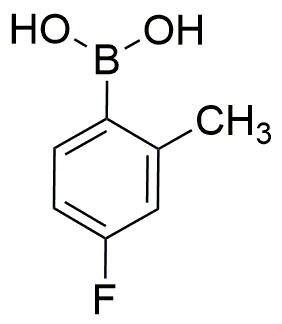4-Fluoro-2-methylphenylboronic acid is widely utilized in research focused on:
- Pharmaceutical Development: This compound serves as a crucial intermediate in the synthesis of various pharmaceuticals, particularly in the development of anti-cancer agents. Its unique properties allow for targeted drug design, enhancing efficacy.
- Organic Synthesis: It is commonly used in Suzuki coupling reactions, which are essential for forming carbon-carbon bonds in organic chemistry. This application is vital for creating complex organic molecules in materials science and drug discovery.
- Bioconjugation: The boronic acid group can selectively bind to diols, making it useful for bioconjugation processes. This is particularly beneficial in creating targeted delivery systems in biotechnology and medical research.
- Sensor Technology: Its ability to form complexes with sugars makes it valuable in developing biosensors for glucose monitoring, which is crucial for diabetes management and research in medical diagnostics.
- Material Science: The compound can be incorporated into polymer matrices to enhance properties such as thermal stability and mechanical strength, making it useful in the production of advanced materials for various industrial applications.
General Information
Properties
Safety and Regulations
Applications
4-Fluoro-2-methylphenylboronic acid is widely utilized in research focused on:
- Pharmaceutical Development: This compound serves as a crucial intermediate in the synthesis of various pharmaceuticals, particularly in the development of anti-cancer agents. Its unique properties allow for targeted drug design, enhancing efficacy.
- Organic Synthesis: It is commonly used in Suzuki coupling reactions, which are essential for forming carbon-carbon bonds in organic chemistry. This application is vital for creating complex organic molecules in materials science and drug discovery.
- Bioconjugation: The boronic acid group can selectively bind to diols, making it useful for bioconjugation processes. This is particularly beneficial in creating targeted delivery systems in biotechnology and medical research.
- Sensor Technology: Its ability to form complexes with sugars makes it valuable in developing biosensors for glucose monitoring, which is crucial for diabetes management and research in medical diagnostics.
- Material Science: The compound can be incorporated into polymer matrices to enhance properties such as thermal stability and mechanical strength, making it useful in the production of advanced materials for various industrial applications.
Documents
Safety Data Sheets (SDS)
The SDS provides comprehensive safety information on handling, storage, and disposal of the product.
Product Specification (PS)
The PS provides a comprehensive breakdown of the product’s properties, including chemical composition, physical state, purity, and storage requirements. It also details acceptable quality ranges and the product's intended applications.
Certificates of Analysis (COA)
Search for Certificates of Analysis (COA) by entering the products Lot Number. Lot and Batch Numbers can be found on a product’s label following the words ‘Lot’ or ‘Batch’.
*Catalog Number
*Lot Number
Certificates Of Origin (COO)
This COO confirms the country where the product was manufactured, and also details the materials and components used in it and whether it is derived from natural, synthetic, or other specific sources. This certificate may be required for customs, trade, and regulatory compliance.
*Catalog Number
*Lot Number
Safety Data Sheets (SDS)
The SDS provides comprehensive safety information on handling, storage, and disposal of the product.
DownloadProduct Specification (PS)
The PS provides a comprehensive breakdown of the product’s properties, including chemical composition, physical state, purity, and storage requirements. It also details acceptable quality ranges and the product's intended applications.
DownloadCertificates of Analysis (COA)
Search for Certificates of Analysis (COA) by entering the products Lot Number. Lot and Batch Numbers can be found on a product’s label following the words ‘Lot’ or ‘Batch’.
*Catalog Number
*Lot Number
Certificates Of Origin (COO)
This COO confirms the country where the product was manufactured, and also details the materials and components used in it and whether it is derived from natural, synthetic, or other specific sources. This certificate may be required for customs, trade, and regulatory compliance.


